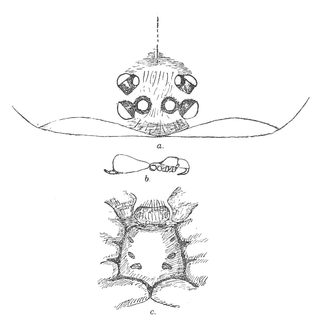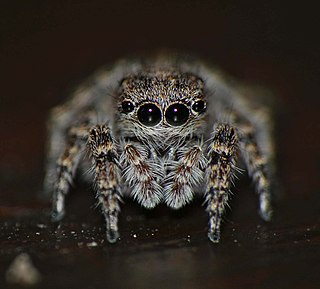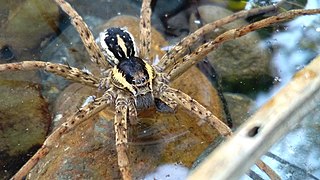Euophrys omnisuperstes, the Himalayan jumping spider, is a small jumping spider that lives at elevations of up to 6,700 m (22,000 ft) in the Himalayas, including Mount Everest, making it a candidate for the highest known permanent resident on Earth. They are found among rocky debris, feeding on tiny, stray springtails and flies.

Porrhothele antipodiana, the black tunnelweb spider, is a species of mygalomorph spider that is endemic to New Zealand. It is the most common and widespread of several species in the genus Porrhothele, and is especially common in the greater Wellington region where the vagrant mature males are often encountered in or around dwellings. This species is one of New Zealand's most studied spiders. In New Zealand, the common name "tunnelweb spider" is also often used to refer to members of the genus Hexathele. Neither should be confused with their distant relatives, the highly venomous Australian funnel-web spiders.

Argiope protensa, commonly known as the tailed grass spider or teardrop spider, is a species of spider in the orb weaver family, Araneidae. This species is fairly common and widespread in Australasia, but like many spider species, little is known of its ecology, biology, or life history.

The Artoriinae are a subfamily of wolf spiders. The monophyly of the subfamily has been confirmed in a molecular phylogenetic study, although the relationships among the subfamilies was shown to be less certain.

Zygoballus sexpunctatus is a species of jumping spider which occurs in the southeastern United States where it can be found in a variety of grassy habitats. Adult spiders measure between 3 and 4.5 mm in length. The cephalothorax and abdomen are bronze to black in color, with reddish brown or yellowish legs. The male has distinctive enlarged chelicerae and front femora. Like many jumping spiders, Z. sexpunctatus males exhibit ritualized courtship and agonistic behavior.

Socca pustulosa is a Orb-weaver spider species in the family Araneidae, and it was first described by a French scientist Charles Athanase Walckenaer in 1841 from Tasmania, Australia, but later on when Walckenaer examined the specimen collected from New Zealand and renamed it as a different species- Epeira verrucosa. Until 1917, Dalmas reviewed the Australian pustulosa and New Zealand verrucosa and realized they were the same species. Although S. pustulosa has been accepted for some time in the genus of Eriophora, the evidence supporting its placement within this genus were not fully convincing. Therefore, an alternative view was proposed in 2022- a new genus established to accommodate pustulosa along with 11 other spider species from Australia; the diagnostic test based on haplotype analysis and systematic morphology study by arachnologists and found the anatomical features of male pedipalp terminal apophysis differs from other orb-web species.

Anoteropsis is a genus of wolf spiders. All the species except one are found in New Zealand and its islands.

Anoteropsis aerescens is a species of wolf spiders, that is distinguished from all other Anoteropsis species by the shape of the median apophysis of the male bulb and the external sclerites of the female epigyne, especially the wide median septum. It is found in New Zealand.

Cantuaria dendyi is a species of trapdoor spider in the family Idiopidae. It can be found in the South Island of New Zealand and is limited to the Christchurch and Banks Peninsula area.
Cedicoides is a genus of spiders in the family Cybaeidae made up of four species. It is characterized by well developed tegulum on the bulb of the male pedipalp. When it was published by Charitonov in 1946, it acted as a subgenus to Cedicus. Later, it was argued that the differences between spiders of Cedicoides and those of other subgenera - notably the presence of a terminal apophysis and the shape of the male pedipalp - were great enough to warrant a new genus. In 2003, it was upgraded from subgenus to genus status by Marusik & Guseinov. Spiders of this genus are rare, and are often missing from spider collections taken from these regions during any time other than their mating season.

Langona hirsuta is a species of jumping spider in the genus Langona that lives in South Africa. It was first described in 2011 by Charles Haddad and Wanda Wesołowska. The spider is large with a carapace between 2 and 3.7 mm long and a abdomen between 1.9 and 4.4 mm long. The female is significantly larger than the male, particularly in the abdomen, which is also wider and a lighter brown. The male has very hairy pedipalps, after which it is named. It has the toothless chelicerae typical of the genus, and a single appendage, or apophysis, on the palpal tibia. The length of the apophysis helps to distinguish it from other spiders in the genus. It lives in semi-arid climates.

Langona tortuosa is a species of jumping spider in the genus Langona that lives in Namibia, South Africa and Zimbabwe. It was first described in 2011 by Wanda Wesołowska, based on a holotype from Caprivi. The spider is large with a cephalothorax between 2.4 and 2.8 mm long and a abdomen between 1.9 and 2.6 mm long. The female is larger than the male. It has the toothless chelicerae typical of the genus. It can be distinguished by its copulatory organs. The male has a hidden embolus that is shorter than that on the related Langona pilosa. The female has long seminal ducts.

Langelurillus minutus is a species of jumping spider in the genus Langelurillus that lives in Namibia and Zimbabwe. It was first described in 2011 by Wanda Wesołowska and Meg Cumming. The spider is small, with a cephalothorax that is between 1.8 and 2.3 mm long and an abdomen between 1.5 and 3.9 mm long. The male is noticeably smaller than the female, which is reflected in the species name. The species is generally brown, but has indistinct patches on its abdomen and orange or orange-yellow legs. The male has a very convex palpal bulb and the female an epigyne with a large pocket and compact multi-chambered receptacles.

Langelurillus quadrimaculatus is a species of jumping spider in the genus Langelurillus that lives in Nigeria. It was first described in 2011 by Wanda Wesołowska and Anthony Russell-Smith. The spider is small, with a cephalothorax that is between 1.7 and 2.5 mm long and an abdomen between 2.0 and 2.2 mm long. The female is larger than the male. It can be distinguished from other species in the genus by its abdominal pattern, which is recalled in the species name, that consists of two pairs of rounded yellow patches on a brownish-grey background. The female also has a distinctive internal layout of its seminal ducts within its short and wide epigyne.

Cantuaria borealis is a native New Zealand species of trapdoor spider.
Periegops suterii is a species of spider in the genus Periegops that is endemic to the South Island of New Zealand.

Anoteropsis litoralis is a species of wolf spider that is endemic to New Zealand.

Anoteropsis hilaris, commonly referred as the garden wolf spider or the grey wolf spider, is a species of wolf spider that is endemic to New Zealand.

The Lincoln University Entomology Research Collection is a collection of approximately 500,000 insect, spider, and other arthropod specimens housed in Lincoln University, New Zealand. Being one of New Zealand's largest insect research collections, it is the only one based in a university.

Dolomedes dondalei is a species of large fishing spider endemic to the main islands of New Zealand. It is a nocturnal hunter, feeling the water surface for vibrations, and catches insects and even small fishes – the only New Zealand Dolomedes species able to do so.

















